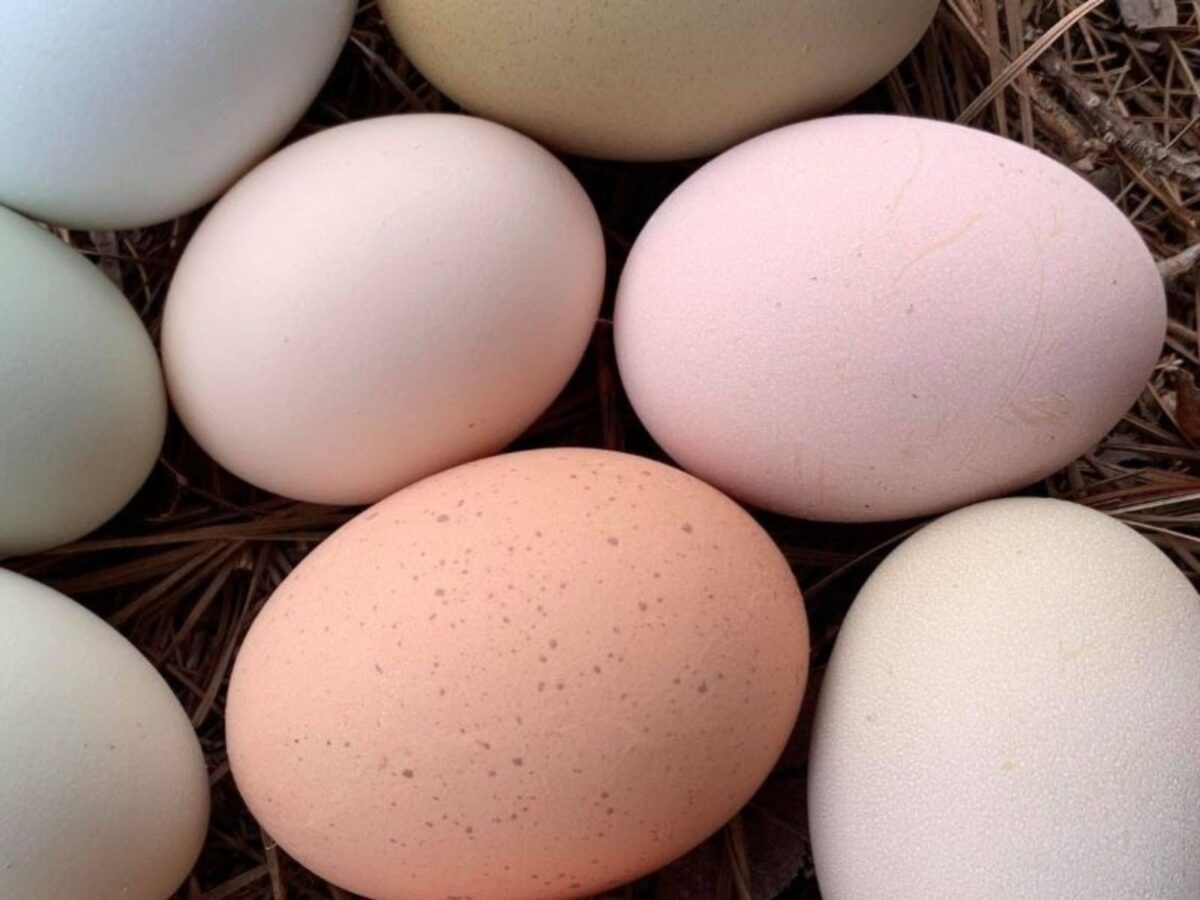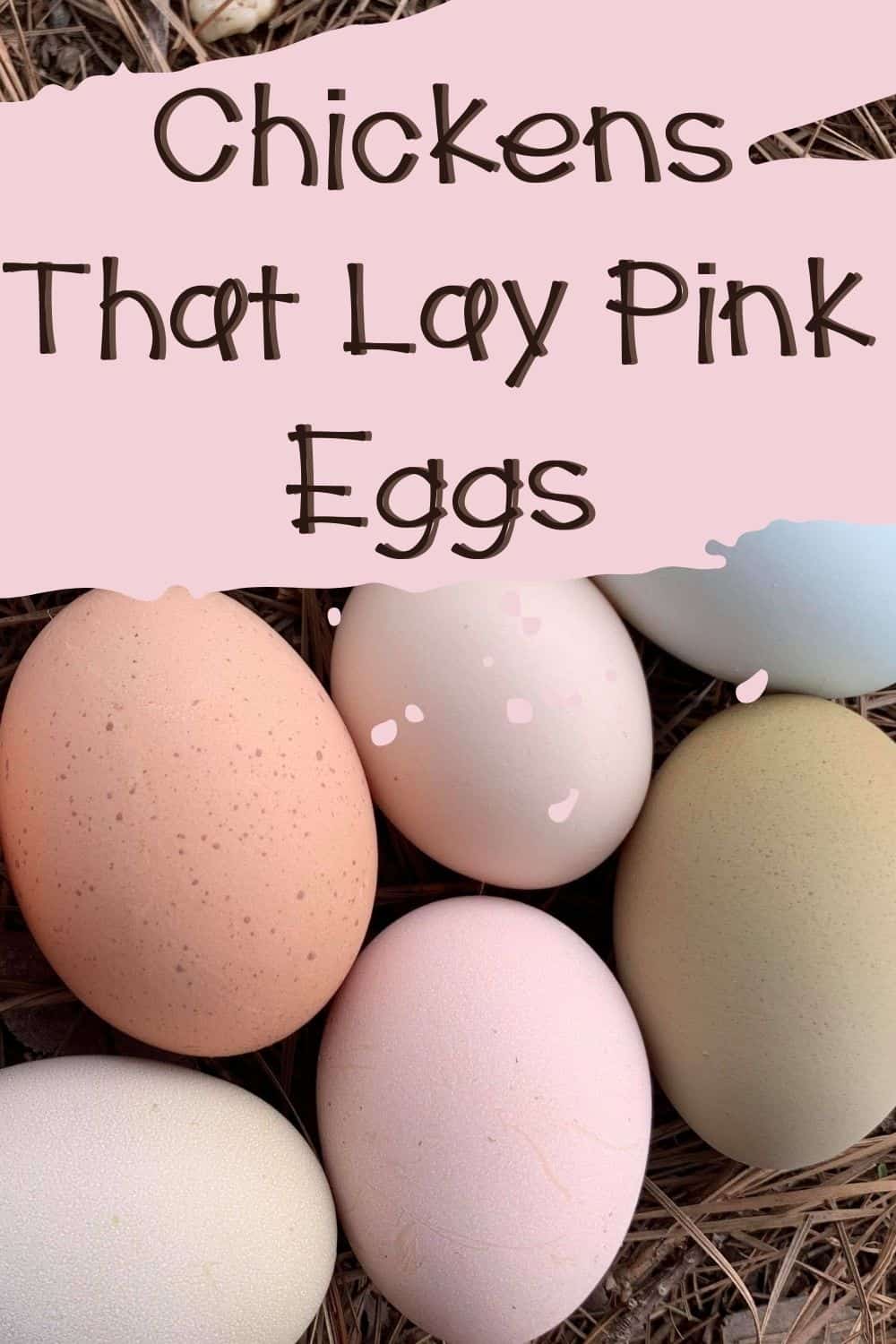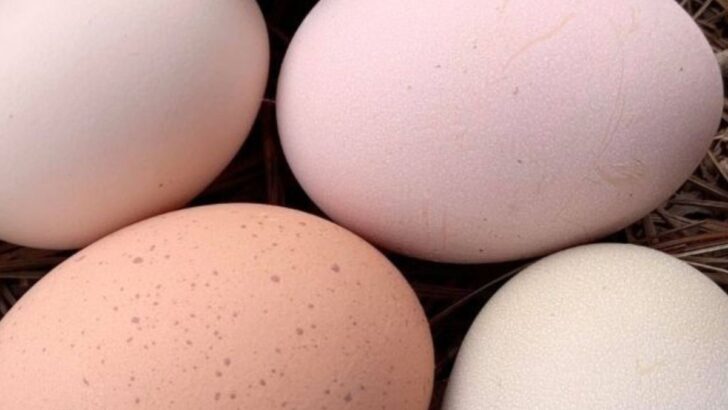We’ve all heard of the goose that laid the golden egg, but what about chickens that lay pink eggs? No, they’re not pre-dying Easter eggs or hosting a gender reveal party. The truth is that chicken eggs actually come in many shades of white, cream, dark brown, green, blue, and pink. What turns an egg pink, and are they safe to eat?

Let’s explore the top 5 facts about chickens that lay pink eggs and then answer some of the most frequently asked questions about these pink egg layers and their colorful eggs.
5 Facts About Pink Egg Layers
- It takes a little more than a full 24-hour day for a chicken to produce an egg, and 20 of those hours are spent forming the shell of the egg.
- Since shells are made of mainly calcium, all eggshells start out white. Pink eggs are believed to be the result of what is called “bloom” which is naturally applied over a light tan egg during its formation.
- As the white shell forms inside the hen, pigmentation starts to be secreted from cells in the hen’s uterus. This pigmentation is known as protoporphyrins or biological pigments. Depending on the tint or shade of the porphyrin, the pigment will form at different stages of shell production, which is why most eggs remain white on the inside.
- What we call pink eggs may be more of a pinkish-cream color or pale brown. Some chicken owners report that their pink eggs will turn brown when they wash them with water but return to pink as they dry.
- The breed of chicken matters, but no one breed assures pink eggs. It ultimately boils down to the individual variation within that breed. Chickens who lay olive, blue, or dark brown eggs bred with one who lays cream-colored eggs may produce a pink egg layer or at least an egg that resembles pink. Those who lay cream-colored eggs may also have a genetic variation to tint their eggs pink.
Want some green egg layers? It’s fun to get a bunch of different colored eggs!
Learn everything you need to know about chickens from this book:
11 Breeds of chicken that lay pink eggs
Pink egg layers are quite rare and come from many different breeds of chickens. The breeds of chickens below will lay pink eggs, but it’s not the norm. It all depends on the variations within the breeds, having a genetic variation that gives them the pink color.
No one breed can guarantee a pink egg layer, but olive eggers, blue egg layers, or dark brown egg-laying chickens bred with a creamy-colored egg layer could create a chicken that lays an egg in a pink shade.
1. Asil
While the Asil may be known to lay pink eggs, they don’t tend to lay very many eggs at about 40 eggs per year.
A few other things to know about this breed: they’re aggressive with each other but not humans! Aggression is an issue especially when they’re confined, so it’s important to have plenty of space for them.
They can be easily handled because they are quite docile around people. The hens make very good mothers who tend to be kind and protective towards their chicks.
2. Some Australorps
Not all Australorps lay pink eggs, but some do. They are very family-friendly and are pretty with their glossy black color with red combs and wattles on the hens and the roosters. This breed is extremely productive in laying eggs.
Australorps lay between 250 and 300 large, light brown eggs every year. Australorps are popular in Australia.
3. Barred Rock
The Barred Rock breed are good layers averaging about 280 eggs each year. The breed is used both as egg layers and for meat. They have dark reddish bay eyes, yellow beaks, and red earlobes. They tend to be very mellow.
They normally lay brown eggs, but occasionally, some will lay pink eggs.
4. Buff Orpington
This beautifully feathered, plump, and stately hen will casually strut around the chicken yard as if she owns the place. They come in a few varieties of colors ranging from buff, black, white, or blue and in two sizes, large fowl and bantams. They have red wattles, combs, and earlobes.
This breed is friendly and docile even loving to be cuddled and great with children. The Buff Orpington tends to lay about 200 to 280 eggs per year.
5. Croad Langshan
This breed is one of the oldest breeds and has long, silky black or white feathers. They tend to be very gentle and calm but heavy and sometimes accidentally trample their eggs.
They lay about 180 to 240 eggs per year. Most eggs are buff or brownish and large, though some lay eggs with a pink bloom.
6. Some Easter Eggers
Also referred to as EE, the Easter Egger is not an official breed but rather a mix of either an Araucana or an Ameraucana, both difficult to find in America, bred with any other breed. ‘
Their eggs tend to be large and colorful, ranging from blue to green, olive, aqua, yellow, and sometimes with a pink hue.
They tend to be friendly to humans, including children, and are hardy. They have beautiful feathers in a variety of patterns. Some even have green feet or legs. The EE is a good egg layer and will produce about 250 eggs per year.
7. Light Sussex
This breed comes in a variety of colored plumage with light or red and speckled ones in the United States. The Light Sussex is a very loved and endearing breed. They are extremely docile yet very alert to their surroundings.
They lay about 250 light pinkish-tan or brown eggs per year.
8. Mottled Javas
No, they’re not a coffee drink. This rare breed gets its name from the isle of Java where they are thought to have originated. They have a striking red eye color contrasted against their four varieties of either black feathers, mottled, white, or auburn.
Mottled Java chickens make great free-range chickens, are hardy yet calm, and are excellent foragers. Their eggs are usually considered to be brown, but some look pinkish. They produce about 150 per year.
9. Plymouth Rock
As the name hints, this is one of America’s oldest breeds with black and white plumage. They lay about 200 large brown eggs per year. Some lay very light tan eggs that look pink with the bloom.
The Plymouth Rock chickens are extremely mellow, sweet, and calm docile birds but are constantly curious. They are also very trusting. So, be prepared for them to follow you around.
10. Salmon Faverolles
Their feathers are a honey salmon color, and they have a pinkish beak with reddish eyes and an adorable beard. They come from a small village in France where they get their name.
The Faverolle chicken tends to be enthusiastic, curious, and noisy, yet they are friendly. Expect around 180 to 200 light brown or pinkish eggs each year.
11. Silkies
Silkies make excellent mother hens, good layers, and are super easy to care for. They take well to free-range environments and are hardy, with black or dark blue skin and blue earlobes.
When not being used for breeding and sitting to hatch, they lay about 100 eggs per year. Their pink eggs tend to be small and not very brightly colored, but they do have a pink tint.
FAQs about chickens that lay pink eggs
Does the rooster determine egg color?
Having a rooster in with a laying hen does not affect the egg color. But, breeding could. Some breeds are more likely to produce pink eggs than others.
Is there a way to predict egg color?
Some say you can predict the egg color by looking at the chicken’s earlobe color. Of course, some chickens have red earlobes, and none make red eggs, so you be the judge.
Do pink eggs taste different?
No. There is no difference in the way different colored eggs taste. Nor is the nutrition different. While some egg buyers insist that brown eggs taste better, it’s probably just their imagination.
Are pink eggs safe to eat?
Absolutely! We have it drilled into our heads that chicken meat is unsafe unless the juices run clear with no pink. However, the color of a chicken egg does not make it unsafe to eat even if it’s pink.





Brandy
Wednesday 8th of February 2023
Our Wyonette hens lay pink eggs, too. They are Golden Laced & Silver Laced.
Laila
Wednesday 25th of September 2024
@Brandy, We have a silver laced wyandotte who lays light pink, our barred rock laid a magenta egg a few times, and our blue cuckoo maran is putting a heavy pink bloom on her eggs consistently. That blue cuckoo maran is paired with a blue cuckoo maran rooster right now. Should I keep that or instead put her with the easter egger rooster or cream legbar rooster?
joeg
Saturday 19th of August 2023
@Brandy, Mine too. Not quite as pink as my eggers pink eggs though. They're silver laced.
Quick Guide To Raising Backyard Chickens
Thursday 28th of July 2022
[…] 11 Breeds Of Chickens That Lay Pink Eggs […]
5 Fun Breeds Of Chickens That Lay Blue Eggs
Monday 2nd of August 2021
[…] as their personalities. Chickens lay white eggs, light cream-colored eggs, beige and taupe eggs, rosy-hued pink eggs, many shades of green colored eggs, and blue eggs. One might ask, “How can this […]